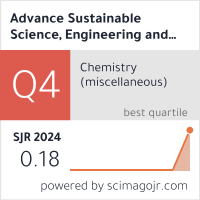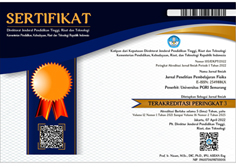Computational Assessment of Orthopedic Implant Durability Using Finite Element Analysis
DOI:
https://doi.org/10.26877/asset.v7i3.1977Keywords:
biomechanics, fatigue, finite element analysis, orthopedic biomechanics, implant validationAbstract
Finite Element Analysis (FEA) provides a rapid and cost-effective method to evaluate orthopedic implants. This research investigates the mechanical performance and long-term durability of a seven-hole SS 316L Basic Fragment Set (BFS) reconstruction plate designed for pelvic fractures. Adhering to ASTM standards, material properties were defined via tensile testing (ASTM E8), while static and fatigue analyses were performed using a displacement control method in a four-point bending test setup in SOLIDWORKS 2024 (ASTM F382). The static analysis predicted failure from plastic deformation at a force of 367 N, with a maximum stress of 621.92 MPa. The fatigue simulation predicted a lifespan of 483,754 cycles. To validate the simulation, these computational results were compared to experimental data, demonstrating high accuracy with deviations of only 3.34% for maximum force and 1.19% for fatigue life. These findings confirm that FEA is a highly reliable tool for predicting mechanical performance, enabling the orthopedic industry to optimize implant designs, enhance patient safety, and improve production efficiency.
References
[1] M. Tile, D. L. Helfet, J. F. Kellam and M. S. Vrahas, Fractures of the Pelvis and Acetabulum, Lippincott Williams & Wilkins, 2015.
[2] R. Perumal, D. C. Raja S, S. P. Sivakumar, D. Jayaramaraju, R. K. Sen, dan V. Trikha, "Management of pelvic injuries in hemodynamically unstable polytrauma patients – Challenges and current updates," Journal of Clinical Orthopaedics and Trauma, vol. 12, no. 1, pp. 101–112, 2021.
[3] A. M. Manson, M. O'Toole, dan M. J. Scalea, "Pelvic fractures in multiple trauma: classification and management," The Journal of the American Academy of Orthopaedic Surgeons, vol. 27, no. 8, pp. 255–263, 2019.
[4] J. Lindahl, "Functional outcome after operative treatment of pelvic ring fractures," Journal of Orthopaedic Trauma, vol. 24, no. 1, p. 39–45, 2010.
[5] K. A. Lefaivre, G. P. Slobogean, J. Valeriote, P. J. O'Brien and S. A. Macadam, "Pelvic ring fractures: a comparison of surgical and non-surgical treatment," Journal of Orthopaedic Trauma, vol. 23, no. 4, p. 251–257, 2009.
[6] M. A. König, M. H. Hessmann, P. Augat and A. Hofmann, "Biomechanical evaluation of different fixation techniques for pelvic ring fractures involving the iliosacral joint," European Journal of Trauma and Emergency Surgery, vol. 40, no. 1, p. 53–60, 2014.
[7] D. Li, H. Ren, X. Zhang, R. Ao, C. Yi and B. Yu, "Finite Element Analysis of Channel Screw and Conventional Plate Technique in Tile B2 Pelvic Fracture," Journal of Personalized Medicine, vol. 2023, no. 3, p. 506, 13.
[8] M. A. Karim, A. Abdelazeem and W. El-Adl, "Fixation of Quadrilateral Plate Fractures of the Acetabulum Using the Anterior Intrapelvic Approach: A Finite Element Study," Journal of Orthopaedic Surgery and Research, vol. 18, p. 100, 2023.
[9] X. Liu, Y. Wang and Y. Zhang, "Comparison Between Novel Anatomical Locking Guide Plate and Conventional Locking Plate for Acetabular Fractures: A Finite Element Analysis," Frontiers in Bioengineering and Biotechnology, vol. 10, p. 987654, 2022.
[10] J. Zhang, Y. Sun and Z. Zhao, "Finite Element Simulation of Internal Fixation for Pelvic Fractures: A Biomechanical Analysis," Medical Engineering & Physics, vol. 85, p. 37–45, 2021.
[11] S. Chao, W. Hu and Y. Lin, "Computational Study on the Effectiveness of Different Plating Techniques for Pelvic Ring Fractures," Journal of Orthopaedic Research, vol. 39, p. 1205–1214, 2021.
[12] R. Lee, T. N. Wong and D. L. Ng, "Finite Element Analysis of Pelvic Fracture Fixation with Different Surgical Techniques," Biomedical Engineering Online, vol. 20, p. 45, 2021.
[13] K. Yamamoto, H. Miyazaki and T. Okabe, "Comparative Finite Element Analysis of Three Pelvic Fixation Techniques Under Different Loading Conditions," Clinical Biomechanics, vol. 88, p. 105284, 2021.
[14] W. C. H. Parr, T. Wang, C. Tan, M. J. Dan, W. R. Walsh and P. Morberg, "Fatigue implications for bending orthopaedic plates," Injury, vol. 52, no. 6, p. 1212–1218, 2021
[15] T. K. Li, J. W. Chan and P. C. Kwan, "Influence of Plate Stiffness on the Healing of Pelvic Fractures: A Numerical Study," Computer Methods in Biomechanics and Biomedical Engineering, vol. 24, p. 1123–1133, 2021.
[16] H. Wang, X. Yang and J. Xu, "Finite Element Analysis of the Structural Integrity of Pelvic Fractures Treated with Different Fixation Methods," Engineering in Medicine and Biology, vol. 23, p. 567–578, 2020.
[17] M. B. Haryono and W. B. Utami, "Plastic Waste Recycle for Industrial," Advance Sustainable Science, Engineering and Technology (ASSET), vol. 2, no. 1, pp. 0200106-1-0200106-5, 2020.
[18] H. Hori, S. Takemura, H. Obata and K. Ogasawara, "Prediction of 4f7−4f65d1 transition energy of Eu2+ in oxides based on first-principles calculations and machine learning," Advance Sustainable Science, Engineering and Technology (ASSET), vol. 2, no. 1, pp. 0200107-1-0200107-6, 2020.
[19] A. E8/E8M-16a, Standard Test Methods for Tension Testing of Metallic Materials, West Conshohocken, PA: ASTM International, 2016.
[20] A. F745, Standard Specification for Cobalt-28 Chromium-6 Molybdenum Alloy Castings and Casting Alloy for Surgical Implants (UNS R30075), West Conshohocken, PA: ASTM International, 2018.
[21] J. E. Shigley, C. R. Mischke and R. G. Budynas, Mechanical Engineering Design, 7th ed., McGraw-Hill, 2004.
[22] Dassault Systèmes, Abaqus Analysis User's Guide True Stress and True Strain in FEA, Dassault Systèmes Simulia Corp., Providence, RI, 2020.
[23] V. Ramaswamy and M. N. Guddati, "On the Use of True Stress and True Strain in Finite Element Analysis of Metal Forming Processes," International Journal of Mechanical Sciences, vol. 113, p. 30–45, 2016.
[24] Q. Chen, Z. Xie, W. Wang and H. Zhang, "The Effect of Contouring on Fatigue Resistance of Three Types of Fracture Fixation Plates," Journal of Orthopaedic Trauma, vol. 33, no. 4, p. 207–215, 2019.
[25] E. Akin, "Mesh Convergence in Finite Element Analysis: A Review," International Journal of Engineering and Technology, vol. 4, no. 5, p. 325–330, 2012.
[26] A. F382, Standard Test Method for the Evaluation of the Bending Strength of Metal Bone Plates, ASTM International, 2020.
[27] H. Prawibowo, F. T. Putri, R. Ismail, M. Tauviqirrahman, R. Novriansyah and Y. Setyoadi, "Finite Element Analysis on a Bionic Foot Prosthesis Model during Walking Gait Phases," in 023 IEEE International Biomedical Instrumentation and Technology Conference (IBITeC), 2023.
[28] A. F. Istiqomah, R. Ismail, D. F. Fitriyana, S. Sulistyo, A. P. Fardinansyah, M. A. Safitri and J. P. Siregar, "Design and Analysis of The Energy Storage and Return (ESAR) Foot Prosthesis Using Finite Element Method," Journal of Biomedical Science and Bioengineering, vol. 1, no. 2, pp. 59-64, 2022.
[29] G. P. Annanto, I. Haryanto and R. Ismail, "A Computational Stress Analysis of Active Prosthetic Hand “Asto Hand V4” for the Loaded Hook Position," in 2021 IEEE International Biomedical Instrumentation and Technology Conference (IBITeC), 2021.
[30] G. P. Annanto, R. Ismail, I. Haryanto, M. Ariyanto, K. A. Pambudi and K. A. Pranoto, "Numerical Analysis of Stress and Displacement on the Index Finger of the Prosthetic Hand Due to Hook Position," in AIP Conference Proceedings, 2019.
[31] R. B. Taqriban, R. Ismail, J. Jamari and A. P. Bayuseno, "Finite Element Analysis of Artificial Hip Joint Implant Made from Stainless Steel 316L," Bali Medical Journal, vol. 10, no. 1, pp. 448-452, 2021.
[32] R. B. Taqriban, R. Ismail, J. Jamari and A. P. Bayuseno, "Computational Analysis of Different Designed Hip Joint Prostheses Using Finite Element Method," in 2020 7th International Conference on Information Technology, Computer, and Electrical Engineering (ICITACEE), 2020.
[33] A. Sedmak, S. Sedmak, F. Vucetic, K. Colic, J. Lozanovic-Sajic, A. Grbovic and Z. Bozic, "Fatigue Crack Growth in Locking Compression Plates," International Journal of Fatigue, 2022.
[34] A. Sedmak, S. Sedmak, F. Vucetic, S. Kirin, K. Colic, F. Berto and A. Grbovic, "Fatigue Life Assessment of Orthopedic Plates Made of Ti6Al4V," Engineering Failure Analysis, 2022.











